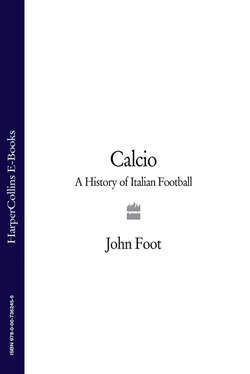Читать книгу Calcio: A History of Italian Football - John Foot - Страница 33
Hunt the Ref! Akkiappa L’Arbitro!
ОглавлениеIn 2003 Enrico Preziosi, games entrepreneur and football chairman, launched a new board game onto the lucrative Italian market. The game was part of a series. It was called Akkiappa L’Arbitro – which loosely translates as ‘Hunt the Referee’ (a dog-catcher is an acchiappacane). The ‘Ks’ instead of the ‘Cs’ are an extra insult, common in Italy but very hard to explain to foreigners.1 The winner, the box says, is the player ‘who hunts down the highest number of characters’. Two large salivating fans are depicted on the front of the game box, cheering. On the back there is a referee, running away. It is a simple game: you are provided with a small plastic football pitch upon which are attached a number of equally big-headed plastic referees, with light-buttons on their tops. Some are completely bald, like Pierluigi Collina, Italy’s most famous match official. Two padded gloves are also included. The object of the game? Hit (akkiappa!) the referee that lights up, in the quickest time possible. That’s it. Hit as many referees, on the head, before your opponent does so, with a padded glove whilst the score is kept, automatically. As a game, Akkiappa L’Arbitro leaves something to be desired. As a metaphor for the relationship between Italians and referees, it is perfect. Not surprisingly, the referees’ association complained about Akkiappa. Preziosi, who had spent the entire 2002–3 season moaning that his then team – Como – had been harshly treated by referees, apologized and said that he would withdraw the game from the shops. In 2004 it was still available. I purchased one in Milan (for £35) in January of that year.
All this might be seen as comic if it were not for the inflammatory consequences of Preziosi’s frequent outbursts. In that same season, when Como were quite clearly not good enough for Serie A, a small group of their fans went crazy after a referee gave three penalties against them in a home match with Udinese. They decided to akkiappare l’arbitro in real life. After a semi-riot, the game was abandoned. It is not difficult to link Preziosi’s conspiracy theories with this violence, and such attitudes rarely bring results. On the contrary, they give the players a great excuse for not trying very hard. It is all the referee’s fault, so why bother running around too much? Akkiappa identified the guilty party in the chaos of Italian football as the referee. He was responsible for all the game’s ills, and as such deserved to be hunted down, beaten up, punished.
A book published in 2004 (and to be found in the ‘comedy’ section of bookstores) was simply a list of incidents involving referees from right across Italy, in minor games of all kinds.2 Here are some examples, from all parts of the peninsula and its islands:
Mortara (Lombardy): ‘after a player was sent off his son came onto the pitch without permission screaming: “referee, you are murdering my players”. Asked to leave by the official, he first struck the ball violently towards the referee, and then kicked him in the leg, causing a strong bruise to emerge; the game had to be abandoned.’
Vercelli (Piedmont), January 1995: ‘The referee of Pro Vercelli-Olbia (Serie C2) gave a penalty to Olbia in injury time at the end of the game. They scored, and the referee blew the final whistle. At this point, he was chased by some Pro Vercelli players to the dressing room, where he remained “barricaded in” for half an hour or so, until the police came to his rescue.’
Carini (Sicily): ‘A player was banned for five years after headbutting the referee, breaking his nose and a tooth. The game was called off.’
Montecchio (Emilia): ‘After the game had finished, a supporter chased the referee on his motorbike for fifteen km, unsettling his driving.’
Calabria: ‘After a player was booked, the same player punched the referee in the face, who was then surrounded by the whole team, spat on, struck and kicked. The group included the stand-in linesman (who was from the same team) who hit the referee with his flag. The game was called off, but the same group of players tried to force the referee to continue and followed him to the dressing room.’
There are 202 pages of stories like this, chosen from official reports, and this is only a small selection of what has become a violent epidemic in Italian sport: Hunt the ref!
